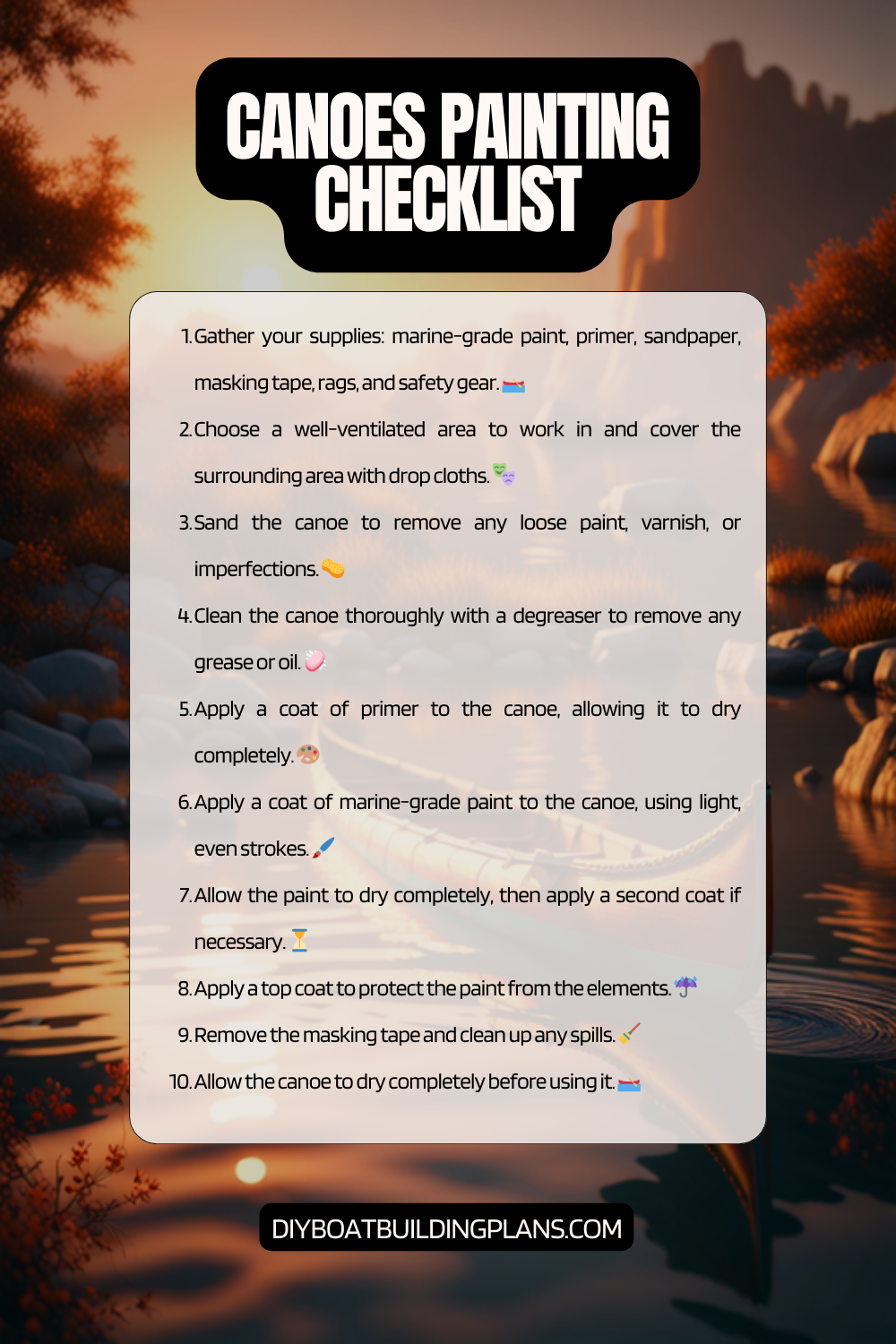Overview of Canoe Painting Tips
Painting a canoe is not just about aesthetics; it is an essential step in maintaining and preserving the longevity of your beloved watercraft. A well-painted canoe not only enhances its appearance but also protects it from the harsh elements it encounters during its adventures on the water. Whether you are a seasoned paddler or a novice, understanding the importance of painting your canoe is crucial.
One of the primary benefits of painting a canoe is the protection it provides against UV rays, water damage, and general wear and tear. The sun’s rays can cause the canoe’s material to fade and weaken over time, making it more susceptible to cracks and leaks. By applying a high-quality paint, you create a barrier that shields the canoe from these harmful effects, ensuring its durability and extending its lifespan.
Key Takeaways
- Choose the right paint for your canoe to ensure durability and longevity.
- Properly prepare your canoe by cleaning and sanding before painting.
- Use primer for maximum adhesion and a smooth finish.
- Apply paint with a brush, roller, or spray paint for a professional look.
- Maintain your canoe’s paint job by regularly cleaning and touching up any chips or scratches.

Choosing the Right Paint for Your Canoe
When it comes to choosing the right paint for your canoe, there are several factors to consider. Firstly, you need to select a paint that is specifically designed for marine applications. Marine paints are formulated to withstand constant exposure to water, UV rays, and other environmental factors that can damage ordinary paints.
There are two main types of paint suitable for canoes: oil-based and water-based. Oil-based paints offer excellent durability and resistance to abrasion, making them ideal for canoes that frequently encounter rough waters or rocky shores. On the other hand, water-based paints are more environmentally friendly and easier to clean up, making them a popular choice for those who prioritize sustainability.
Other factors to consider when choosing paint include color options, drying time, and ease of application. It is advisable to consult with experts or read product reviews to ensure you make an informed decision that suits your specific needs.
Preparing Your Canoe for Painting
Before diving into the painting process, proper preparation is essential to achieve a flawless finish. The first step is cleaning the canoe thoroughly. Remove any dirt, grime, or residue using a mild detergent and water. Pay close attention to areas that are prone to buildup, such as the bottom of the canoe and the gunwales.
Next, if your canoe has old paint that is chipping or peeling, it is crucial to remove it completely. Use a paint scraper or sandpaper to strip away the old paint until you reach the bare surface. This step ensures that the new paint adheres properly and prevents any inconsistencies in the final result.
Once the old paint is removed, inspect the canoe for any damages or imperfections. Repair any cracks, dents, or holes using an appropriate filler or epoxy. Sand down the repaired areas to create a smooth surface that seamlessly blends with the rest of the canoe.
Sanding Techniques for a Smooth Finish
| Sanding Technique | Description | Advantages | Disadvantages |
| Hand Sanding | Sanding by hand using sandpaper or sanding blocks. | Controlled sanding, good for small areas, inexpensive. | Time-consuming, can cause uneven sanding, can be tiring. |
| Power Sanding | Sanding using a power tool such as an orbital sander or belt sander. | Efficient, saves time, good for large areas. | Can be expensive, can cause damage if not used properly, can be noisy. |
| Wet Sanding | Sanding using water to lubricate the sandpaper and reduce dust. | Produces a smooth finish, reduces dust, good for finishing coats. | Can be messy, requires more time and effort, can cause rust if not dried properly. |
| Dry Sanding | Sanding without water or lubrication. | Good for rough sanding, can be done quickly, less messy. | Produces more dust, can cause scratches, not suitable for finishing coats. |
Sanding is a critical step in achieving a smooth and professional-looking finish on your canoe. It helps remove any remaining traces of old paint, smooth out imperfections, and create a surface that allows the new paint to adhere properly.
When sanding your canoe, start with a coarse-grit sandpaper to remove any rough patches or stubborn residue. Gradually move to finer-grit sandpapers to achieve a smoother finish. It is essential to sand in the direction of the wood grain or canoe material to avoid creating scratches or uneven surfaces.
For fiberglass canoes, use wet sanding techniques by soaking the sandpaper in water before sanding. This helps prevent dust particles from becoming airborne and provides a smoother sanding experience.
Priming Your Canoe for Maximum Adhesion
Priming your canoe is a crucial step that ensures maximum adhesion of the paint and enhances its durability. Primer acts as a bonding agent between the surface of the canoe and the paint, creating a strong foundation for a long-lasting finish.
Before applying primer, make sure your canoe is clean and dry. Choose a primer that is specifically designed for the material of your canoe, such as wood or fiberglass. Apply the primer evenly using a brush or roller, following the manufacturer’s instructions regarding drying time and number of coats.
Priming not only improves adhesion but also helps seal the surface, preventing any moisture from seeping into the canoe. This is particularly important for wooden canoes, as moisture can lead to rotting and structural damage over time.
Applying Paint with a Brush or Roller
When it comes to applying paint to your canoe, you have two main options: using a brush or a roller. Both techniques have their advantages and can be used interchangeably depending on personal preference and the desired finish.
Using a brush allows for more control and precision, especially when painting intricate areas or creating custom designs. It is recommended to use high-quality brushes with synthetic bristles that are specifically designed for marine applications. Start by applying thin coats of paint, allowing each coat to dry before applying the next. This helps prevent drips, runs, and uneven coverage.
If you prefer a smoother and more uniform finish, using a roller can be an excellent choice. Rollers are particularly effective for larger surfaces, such as the sides of the canoe. Opt for foam rollers that provide even coverage and minimize streaks or bubbles. Apply the paint in long, even strokes, working from one end of the canoe to the other.
Regardless of the technique you choose, it is essential to maintain a consistent pressure and avoid overworking the paint. This helps achieve a seamless finish without any visible brushstrokes or roller marks.
Using Spray Paint for a Professional Look
For those seeking a professional-looking finish with minimal effort, spray paint can be an excellent option. Spray paint provides an even application and allows for quick coverage of large areas.
One of the significant benefits of using spray paint is its ability to reach tight corners and crevices that may be challenging to access with a brush or roller. This makes it ideal for canoes with intricate designs or patterns.
To achieve the best results with spray paint, it is crucial to prepare the surface properly and apply thin, even coats. Start by cleaning and priming the canoe as mentioned earlier. When spraying, maintain a consistent distance from the surface and move the can in a smooth, sweeping motion. Avoid spraying too close or holding the can in one spot for too long, as this can result in drips or uneven coverage.
Creating Custom Designs and Patterns
Painting your canoe provides an opportunity to unleash your creativity and personalize your watercraft. Custom designs and patterns not only make your canoe stand out but also reflect your personality and style.
When creating custom designs, it is essential to plan ahead and sketch your ideas on paper before applying them to the canoe. This helps visualize the final result and make any necessary adjustments.
There are various techniques you can use to create custom designs on your canoe. One popular method is stenciling, where you use pre-cut stencils to paint specific shapes or patterns onto the canoe. Another technique is freehand painting, where you directly apply paint using brushes or sponges to create unique designs.
To achieve a professional look, it is advisable to practice on a scrap piece of material before painting directly on the canoe. This allows you to refine your technique and ensure that you are satisfied with the design before committing it to your watercraft.
Tips for Painting Canoe Accessories
In addition to painting the canoe itself, you may also want to consider painting its accessories for a cohesive look. Canoe accessories such as paddles, seats, and yokes can be painted to match or complement the color scheme of your canoe.
When painting accessories, it is crucial to choose paints that are suitable for the specific material of each item. For example, if you are painting wooden paddles, opt for paints that are designed for wood applications. Similarly, if you are painting plastic or metal accessories, choose paints that adhere well to those materials.
Before painting, clean the accessories thoroughly and sand them lightly to create a surface that allows the paint to adhere properly. Apply thin coats of paint, allowing each coat to dry before applying the next. This helps achieve a smooth and even finish.
Download over 500 Boat Plans. Click on the link below.
-->Click Here<--
Maintaining Your Canoe’s Paint Job
Once you have invested time and effort into painting your canoe, it is essential to maintain its appearance and protect the paint job for years to come. Regular maintenance not only keeps your canoe looking its best but also prevents any potential damage or deterioration.
To maintain your canoe’s paint job, start by cleaning it regularly with mild soap and water. This helps remove any dirt or debris that may accumulate over time. Avoid using harsh chemicals or abrasive cleaners, as they can damage the paint.
Inspect your canoe periodically for any signs of wear or damage. Touch up any areas that may have chipped or faded using the same paint color and technique as the original application. This helps maintain a consistent appearance and prevents further deterioration.
Additionally, consider storing your canoe in a shaded area or using a protective cover when it is not in use. This helps shield it from direct sunlight and other environmental factors that can cause the paint to fade or deteriorate.
Common Mistakes to Avoid When Painting a Canoe
While painting a canoe can be a rewarding experience, there are common mistakes that can hinder the final result. By being aware of these mistakes and taking precautions, you can avoid them and achieve a flawless finish.
One common mistake is rushing the preparation process. Properly cleaning, sanding, and priming the canoe are crucial steps that should not be overlooked. Skipping these steps can result in poor adhesion, uneven coverage, and premature paint failure.
Another mistake is applying too thick of a coat of paint. Thick coats take longer to dry and are more prone to drips, runs, and uneven coverage. It is better to apply multiple thin coats, allowing each coat to dry before applying the next. This ensures a smoother finish and reduces the risk of imperfections.
Lastly, not following the manufacturer’s instructions regarding drying time and application techniques can lead to subpar results. Each paint product has specific guidelines that should be followed for optimal performance. Take the time to read and understand these instructions before starting the painting process.
Canoe Painting Checklist

Conclusion – Canoe Painting Tips
In conclusion, painting a canoe is not only about enhancing its appearance but also about protecting it from the elements and ensuring its longevity. By choosing the right paint, properly preparing the canoe, and applying the paint with care, you can achieve a beautiful and durable finish.
Remember to consider factors such as paint type, surface preparation, and application techniques when embarking on your canoe painting journey. Take your time, practice patience, and follow the tips provided in this article to avoid common mistakes and achieve a professional-looking result.
So, grab your brushes or spray cans, unleash your creativity, and transform your canoe into a work of art that reflects your passion for paddling. Happy painting!
FAQs – Canoe Painting Tips
What is canoe painting?
Canoe painting is the process of applying paint or other coatings to the exterior or interior of a canoe to protect it from the elements and enhance its appearance.
What are some tips for preparing a canoe for painting?
Before painting a canoe, it is important to clean and sand the surface to remove any dirt, debris, or old paint. It is also recommended to use a primer to help the paint adhere to the surface.
What type of paint should be used for canoe painting?
Marine-grade paint or epoxy-based paint is recommended for canoe painting as it is designed to withstand exposure to water and UV rays.
What are some tips for applying paint to a canoe?
When applying paint to a canoe, it is important to use a high-quality brush or roller and apply thin, even coats. It is also recommended to work in a well-ventilated area and wear protective gear such as gloves and a mask.
How long does it take for paint to dry on a canoe?
The drying time for paint on a canoe can vary depending on the type of paint used and the weather conditions. Generally, it can take anywhere from a few hours to a few days for the paint to fully dry.
How often should a canoe be repainted?
The frequency of repainting a canoe depends on how often it is used and how well it is maintained. Generally, it is recommended to repaint a canoe every 3-5 years to maintain its appearance and protect it from the elements.



